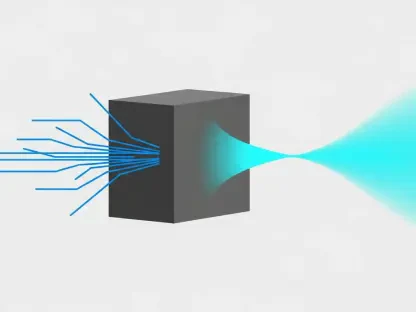The dynamic landscape of telecommunications is constantly evolving, and the O-RAN ALLIANCE is leading this transformation by fostering openness, intelligence, and virtualization in the Radio Access Network (RAN). Established as a global collaborative organization, the O-RAN ALLIANCE aims to enhance interoperability, drive innovation, and support diverse vendors. Throughout the year, the organization has made substantial advancements in the deployment of 5G while setting the stage for the emergence of 6G, as evidenced by their pivotal role at the MWC Barcelona summit.
Achieving Interoperability and Efficiency
Enabling High-Performance, Interoperable Open Fronthaul
One of the key objectives identified by the O-RAN ALLIANCE is to enable high-performance, interoperable open fronthaul for efficient massive Multiple-Input Multiple-Output (MIMO) operations. This focus on open fronthaul is critical for achieving seamless communication between different network components, facilitating the interconnection of equipment from various vendors. By promoting standards-based interoperability, the O-RAN ALLIANCE ensures that network operators can deploy and scale their 5G networks more cost-effectively, without being locked into proprietary solutions.
The emphasis on efficient massive MIMO operations is particularly significant in addressing the growing demand for data and the need for enhanced network capacity. Massive MIMO technology leverages multiple antennas to improve spectral efficiency, providing faster and more reliable connections. The development of open fronthaul standards enables the integration of massive MIMO technology into diverse network architectures, ensuring that the performance and scalability requirements of modern networks are met. This approach not only enhances the user experience but also drives innovation by enabling new applications and services.
Advanced AI-Driven Network Management and Control
In parallel with the focus on interoperability, the O-RAN ALLIANCE is advancing the development of AI-driven network management and control through a mature RAN Intelligent Controller (RIC) and a decoupled Service Management and Orchestration (SMO) framework. The RIC plays a pivotal role in enabling real-time optimization of network resources, leveraging advanced machine learning algorithms to predict and respond to changes in network conditions. This intelligent approach to network management enhances the efficiency and performance of 5G networks, ensuring that resources are allocated dynamically to meet varying demands.
The decoupled SMO framework further enhances the flexibility and scalability of network management. By separating the orchestration layer from the underlying network functions, operators can more easily deploy and manage a wide range of services. This modular approach facilitates the integration of third-party applications and services, driving innovation and enabling the development of new revenue streams. The combination of RIC and SMO represents a significant leap forward in the evolution of network management, paving the way for more agile and responsive 5G networks.
Ensuring Security and Innovation
Enhanced Security Measures with Zero Trust Architecture
As networks become more complex and interconnected, the importance of robust security measures cannot be overstated. The O-RAN ALLIANCE emphasizes the adoption of Zero Trust Architecture (ZTA) and an expanded security assurance program to safeguard the integrity and confidentiality of network data. ZTA is a security model that assumes that threats can exist both inside and outside the network perimeter, requiring continuous verification of entities attempting to access resources. This approach minimizes the risk of unauthorized access and ensures that security policies are consistently enforced across the network.
The expanded security assurance program complements the ZTA model by providing a comprehensive framework for assessing and mitigating security risks. This program includes rigorous testing and validation processes to ensure that network components and applications meet stringent security standards. By implementing these enhanced security measures, the O-RAN ALLIANCE aims to build trust in the O-RAN ecosystem, enabling operators to deploy and manage networks with greater confidence.
AI Integration and the RAN Information Exposure Framework
Throughout the year, the O-RAN ALLIANCE has laid the foundation for AI integration in RAN, including RIC-enabled energy saving, massive MIMO optimization, and the implementation of the RAN Information Exposure (RAIE) framework. This framework is designed to expose network status information to third parties, enabling the development of innovative applications that leverage real-time data. The RAIE framework facilitates collaboration between network operators and application developers, driving the creation of new services and enhancing the user experience.
The RIC-enabled energy-saving initiatives underscore the O-RAN ALLIANCE’s commitment to sustainability. By optimizing network operations based on real-time data, significant energy savings can be achieved, reducing the environmental impact of 5G networks. Similarly, the optimization of massive MIMO operations through AI integration ensures that network resources are utilized efficiently, enhancing performance while minimizing costs. The combination of AI-driven optimization and the RAIE framework represents a holistic approach to network innovation, enabling more intelligent and adaptive network solutions.
Collaboration and Future Vision
Unified Vision for 6G and Regional Alignment
The summit at MWC Barcelona featured a strategic collaboration between the O-RAN ALLIANCE and the 3rd Generation Partnership Project (3GPP) to ensure a unified vision for 6G. This collaboration aims to seamlessly integrate O-RAN’s open RAN solutions into the broader 6G ecosystem, ensuring that the principles of openness, intelligence, and security are maintained. By working together, the O-RAN ALLIANCE and 3GPP aim to develop a cohesive framework that addresses the evolving needs of the telecommunications industry.
The summit also addressed regional efforts by standardization bodies, such as ATIS (North America), ETSI (Europe), Japan’s Ministry of Internal Affairs and Communications, and TTA (Republic of Korea), to align with O-RAN specifications and prevent fragmentation. This regional collaboration is crucial for achieving global standardization and ensuring that the benefits of open RAN are realized across different markets. By aligning regional standards with O-RAN’s specifications, the risk of market fragmentation is minimized, enabling a more unified and interoperable global network infrastructure.
Supporting Diverse Industry Vertical Needs
The O-RAN ALLIANCE is committed to supporting various industry verticals, including healthcare, manufacturing, and transportation, by offering flexible, intelligent, and customizable network architectures. These industry-specific solutions address the unique needs and demands of different sectors, driving innovation and enabling new applications. For instance, specialized high-performance uplink connectivity enabled by O-RAN solutions was utilized during the Paris Olympics, demonstrating the practical benefits of open RAN in real-world scenarios.
The flexible and customizable nature of O-RAN solutions allows network operators to tailor their deployments to specific use cases, ensuring that performance and reliability requirements are met. In healthcare, for example, low-latency and high-reliability communications are critical for applications such as remote surgery and telemedicine. In manufacturing, smart factories require robust and high-capacity networks to support automation and real-time monitoring. The O-RAN ALLIANCE’s commitment to supporting diverse industry verticals underscores its role in driving innovation across different sectors, paving the way for a more connected and intelligent future.
Key Takeaways and Future Directions
The telecommunications field is continually evolving, with the O-RAN ALLIANCE at the forefront of this transformation. Their focus on openness, intelligence, and virtualization within the Radio Access Network (RAN) is reshaping the industry. Created as an international collaborative entity, the O-RAN ALLIANCE’s mission is to boost interoperability, fuel innovation, and create opportunities for a variety of vendors. Over the past year, the organization has made significant strides in advancing 5G technology and is preparing for the future rollout of 6G. Their influential participation at the MWC Barcelona summit underscores their essential role in the industry. The O-RAN ALLIANCE’s efforts are pivotal in driving the next generation of telecommunications infrastructure, ensuring that advancements not only meet but also anticipate future demands. By promoting a more inclusive and competitive RAN ecosystem, the alliance is poised to leave a lasting impact on global communications.








